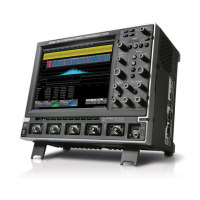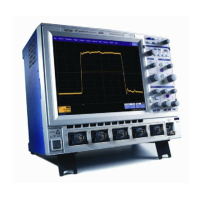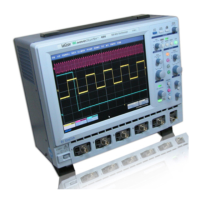160 WM-OM-E Rev I
• The trace on which the histogram is to be displayed
• The maximum number of parameter measurement values to be used in creating the
histogram
• The measurement range of the histogram
• The number of bins to be used
Some of these are pre-defined but can be changed. Once they are defined, the oscilloscope is
ready to make the histogram. The sequence for acquiring histogram data is as follows:
1. Trigger
2. Waveform acquisition
3. Parameter calculations
4. Histogram update
5. Trigger re-arm
If you set the timebase for non-segmented mode, a single acquisition occurs prior to parameter
calculations. However, in Sequence mode an acquisition for each segment occurs prior to
parameter calculations. If the source of histogram data is a memory, saving new data to memory
effectively acts as a trigger and acquisition. Because updating the screen can take much
processing time, it occurs only once a second, minimizing trigger dead time. Under remote control
the display can be turned off to maximize measurement speed.
Parameter Buffer
The oscilloscope maintains a circular parameter buffer of the last 20,000 measurements made,
including values that fall outside the set histogram range. If the maximum number of events to be
used for the histogram is a number `N' less than 20,000, the histogram will be continuously updated
with the last `N' events as new acquisitions occur. If the maximum number is greater than 20,000,
the histogram will be updated until the number of events is equal to `N.' Then, if the number of bins
or the histogram range is modified, the scope will use the parameter buffer values to redraw the
histogram with either the last `N' or 20,000 values acquired -- whichever is the lesser. The
parameter buffer thereby allows histograms to be redisplayed, using an acquired set of values and
settings that produce a distribution shape with the most useful information.
In many cases the optimal range is not readily apparent. So the scope has a powerful range finding
function. If required it will examine the values in the parameter buffer to calculate an optimal range
and redisplay the histogram using it. The instrument will also give a running count of the number of
parameter values that fall within, below, or above the range. If any values fall below or above the
range, the range finder can then recalculate to include these parameter values, as long as they are
still within the buffer.
Capture of Parameter Events
The number of events captured per waveform acquisition or display sweep depends on the
parameter type. Acquisitions are initiated by the occurrence of a trigger event. Sweeps are
equivalent to the waveform captured and displayed on an input channel (1, 2, or 3 or 4). For
non-segmented waveforms an acquisition is identical to a sweep. Whereas for segmented
